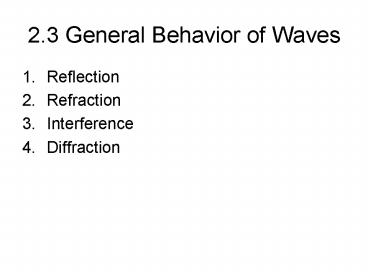2.3 General Behavior of Waves - PowerPoint PPT Presentation
Title:
2.3 General Behavior of Waves
Description:
... Tube Path Length Difference and Interference Interference along antinodal and nodal lines Noise-canceling headphones utilize destructive interference ... – PowerPoint PPT presentation
Number of Views:99
Avg rating:3.0/5.0
Title: 2.3 General Behavior of Waves
1
2.3 General Behavior of Waves
- Reflection
- Refraction
- Interference
- Diffraction
2
Reflection
The law of reflection The angle of incidence
The angle of reflection.
3
Reflection and Huygenss wavelets
4
Parabolic Reflector
5
Ellipse
6
Whispering Chamber
7
Refraction
The bending of a wave as it passes from one
medium to another is called refraction.
8
Refraction is due to changes in Wavespeed
9
Refraction and Speed of the Wave
10
Refraction of wavesIllustrated using Huygenss
wavelets
11
Waves at a beach
12
Voices travel further at night, than during the
day
13
With the wind or Into the wind
14
Range of thunder
15
Interference
- Interference refers to the combining or addition
of two similar waves. - Interference can be destructive, resulting in the
effective disappearance of the waves, when they
are out of phase. - It can be constructive, resulting in the
enhancement of the waves, when they are in phase.
16
Destructive Interference
17
Constructive Interference
18
Quinckes Interference Tube
19
Path Length Difference and Interference
20
Interference along antinodal and nodal lines
21
Noise-canceling headphones utilize destructive
interference
22
Diffraction of Sound
23
Diffraction
Diffraction is the bending of waves around
obstacles or the edges of an opening in the same
medium. It can be explained using Huygenss
principle. The amount of diffraction depends on
the nature of waves and their wavelength. Sound
waves diffract much more than light
waves. Low-frequency (high-wavelength) sound
waves diffract more than high-frequency
(low-wavelength) light waves.
24
Diffraction in Speakers
Small-diameter speakers, called tweeters, are
used to produce high-frequency sound. The small
diameter helps to promote a wider dispersion of
the sound. The amount of bending is depends on
the ratio ?/w, ?
is the wavelength and w is the width of the
opening.































